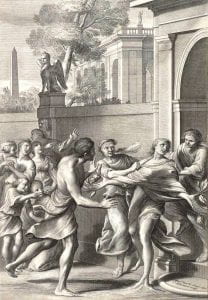The story of Harmonillus, a lemon-fingered boy

‘Harmonillus Transformed into a Citron Tree’ sounds like the title of a myth direct from antiquity but in fact it was first written in the 17th-century. Giovanni Battista Ferrari, a Jesuit priest from Siena, invented this tale for his book Hesperides sive de malorum aureorum cultura et usu, published by Sumptibus Hermanni Scheus in Rome, 1646. This book, whose title translates to Hesperides, or about the cultivation and use of golden apple trees, contains four chapters, each containing a detailed discussion of various citrus fruits, including classifications of their genera. This work is considered one of the earliest and most thorough attempts to survey and record a genus within the plant world (Freedberg 291). The title refers to the Hesperides, the nymphs of sunset and evening, who were charged with protecting the golden apple tree of Gaea, thus giving them a strong association with the care and knowledge of fruits. Ferrari’s self-penned myth of Harmonillus is in the second chapter ‘De Malo Citreo’, and is used by Ferrari to explain the existence of Malum citreum digitatum seu multiforme (fingered, or rather multi-shaped, citrus fruits). Ferrari did not have a scientific explanation for the existence of citrus formed with protruding “fingers” or other irregularities aside from their usual smooth round shape. Creating a story in the style of a classical myth filled this gap while maintaining the authority given through an association with classical learning. The story of the nymph Daphne who transforms into a laurel tree to escape the advances of Apollo is a clear inspiration. Ferrari begins the tale, or fabula, rather ostentatiously, writing:
Audite iam universi, toto que disterminati terrarum orbe mortales: audite viventes & posteri mirabilis pomi originem plane miserabilem: veteremque cognoscite ac lugete sub involucro tragice fabulae historiam (81)
[Listen now everyone, you mortals in every part and divided sphere of lands: listen intently all you alive and your descendants about the miserable race of the miraculous apple tree: mourn as if in a tragedy and learn ancient history during this obscured tale.]
This “ancient history” tells of Harmonillus, a boy with such a beautiful singing voice he is sent to train at Apollo’s academy. He fails to achieve the favour of his fierce matron Vafronia Rabiria, who bans him from singing. Desperately upset, Harmonillus follows a friend of his to an abandoned garden, on the pretense that there he would be free to sing. Alas, the friend was treacherous, and Harmonillus had walked straight into a trap. Upon realising so he begins to cry such abundant tears he turns into a citrus tree.
Sic totus Harmonillus digitatam in Citrum degeneravit (87)
[Thus, the entirety of Harmonillus degenerated into a citrus with fingers.]
In the engraving by Cornelius Bloemaert, after a drawing by Andrea Sacchi, the fingers of the unfortunate Harmonillus can be clearly seen morphing into the leaves and fruit of lemons, the progenitors of Ferrari’s hand-esque citrus. Bloemaert was a Dutch engraver who found success in Rome and lived there until his death. Coming from a family of artists and engravers, he enjoyed a successful reputation as a prolific engraver of Italian art. His style of square-crosshatching brings great depth to his work, and one can sense the terror and marvel of those watching Harmonillus’ shocking transformation, and the despair of the poor boy with the lovely singing voice as he faces his fate, bitter as a lemon.
Adelaide Greig
Print Room Intern
References and further reading
Ferrari, Giovanni Baptista, Hesperides sive de malorum aureorum cultura et usu, Sumptibus Hermanni Scheus (Rome, 1646), pdf of copy held by Bibliothèque de la Ville de Lyon
Freedberg, Davi,. ‘Ferrari on the Classification of Oranges and Lemons’ in Florence and Rome from Grand-Duke Ferdinand I to Pope Alexander VII, eds. E. Cropper, G. Perini, and F. Solinas. (Bologna, Nuova Alfa Editoriale), 287-306.
“Cornelius Bloemaert”, Fine Arts Museums of San Francisco, 2020.
Categories
Leave a Reply